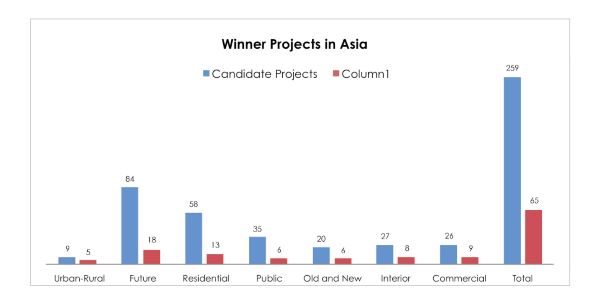Overview 2ACAA 2018
Editorial of 2A Magazine issue 43- Ahmad Zohadi
2A Magazine as organizer of 2A Continental Architectural Awards for Asia & Europe hopes to achieve a broader goal. Which is bringing architects who are also creative artists together and ideas, a forum for all architects around the Globe to expand and enrich their vision about architecture, sharing ideas from various origins, contextual analysis and studies in the continents,
friendship, disseminate the wave of unity, unique global global opportunity for professional interaction and etc.
2A magazine’s activities also are not limited to merely publishing architectural contents , or hold awards , The 2A ‘s activities such as organizing Annual architectural award are in fact shaping and creating a new transformative trend which would help the art of architecture to flourish and be presented multi-dimension-ally by expanding interactions, and helping architects to expand their horizons to become more creative and professionally aware of multiple aspects of this amazing art and profession.
2ACAA will be a landmark and turning point allowing practitioners to pause and reflect upon what the continents, as a part of global community have achieved in the field of Architecture which is an art and a profession and plays a multi- dimensional role in any society. its function and responsibility is not merely to create beautiful living spaces, it has to reflect and respond to the social, cultural and economical needs nd challenges of that society, country, region and continent.
Over Review 2ACAA 2018
The following report briefly outlines the structure of the 2A Continental Architectural Award for Asia and Europe 2017, articulating the process and the considerations made to select the winning projects. This report is divided into three distinct parts, the broad objectives of the award – judging criteria – judging process.
Broad Objectives of the Award
The 2018 2A Continental Architectural Award was an open award for anyone in the national or international architectural community who had designed or built a project in Asia and Europe during or after the year 2010. The award announcement was published broadly in numerous architecture publications and other media outlets in order to invite individuals or groups to participate.
The theme of this year’s award was “Innovative Contextual Architecture in Asia and Europe”. Accordingly, the Award recognized an individual or group’s substantial contribution to today’s architecture in Asia in terms of contemporary challenges in the field and region, which had a lasting influence on the theory and practice of architecture.
2A Magazine, the organizer of the award, has always emphasized on unique regional distinctions, rather than global modernism in architecture and the associated extinction of cultural identity.
Accordingly, this award provided a context for recognizing and highlighting the essence of architectural identity in Asia and Europe beside presenting it to an international audience.
Detailed Judging Criteria
The organizing committee set up a two-stage judging process and detailed judging criteria based on the award announcement.
These were distributed to the jury members to solicit their feedback. The award criteria was also published on the website.
The organizing committee developed a detailed set of guidelines for the jury members to use when evaluating projects, and distributed it to them in advance of the judgment process. In the online review, the criteria were displayed on every page. There were three sets of criteria for the seven categories of projects:
1- Criteria for all categories except interior and urban design:
-Design achievement
– Technical advancement, including engineering achievements (structural, mechanical, etc.) and innovative use of materials
– Reflection of sense of place, ecology, environmental sustainability, and cultural identity
– Social responsibility, community, and urban connectivity
– The effects of economic conditions on the project
2- Criteria for urban projects:
– Design achievement
– Contextual analysis and study
– Reflection of sense of place, ecology, environmental sustainability, and cultural identity
– Social responsibility, community, and urban connectivity
– The effects of economic conditions on the project
3- Criteria for interior projects:
– Design achievement
– Technical advancement, including engineering achievements (construction detail, structural, mechanical, etc.)
– Innovative use of materials and experimentation with new materials
– Reflection of sense of place, ecology, environmental sustainability, and cultural identity
– Social and economic responsibility
Judging Process
The award review had a two-stage process, blind review and discussion review.(Figure 1)
Blind Review with Online Scoring
In this stage, two PDF files and a project description for each entry, and consider them based on the general goal of the prize. The purpose of the contest was to locate and highlight contemporary urban, landscape, and architectural works in Asia and Europe whose innovative characteristics epitomized the Search for Asian and European Spirit in Architecture, and who contributed to a new direction and order for the cities in these continents.
Based on the judging criteria, each project could pass. Each was reviewed and evaluated with other projects in the same category. Although the majority of the evaluation criteria were common among all categories, each category’s submissions were evaluated separately. In the end the jury members chose the candidate projects for the next stage.
Discussion Review in Berlin In this final stage, award winners were selected based on a selective basis. All of the jury members had copies of the competition criteria and reviewed the projects accordingly.
During the deliberations, selection decisions were made in several rounds and by voice vote. Each jury determined his own voting procedures. More important than the tally procedure, though, was the exchange of views taking place during the jury’s deliberations. The final decisions evolved from that dialogue.
Note1: The category of Future in Asia Architecture Award has been divided to for subcategories [Large, medium, small & Urban]
Note2: The category of Residential in Asia Architecture Award has been divided to two subcategories of [Vila and Apartment]


